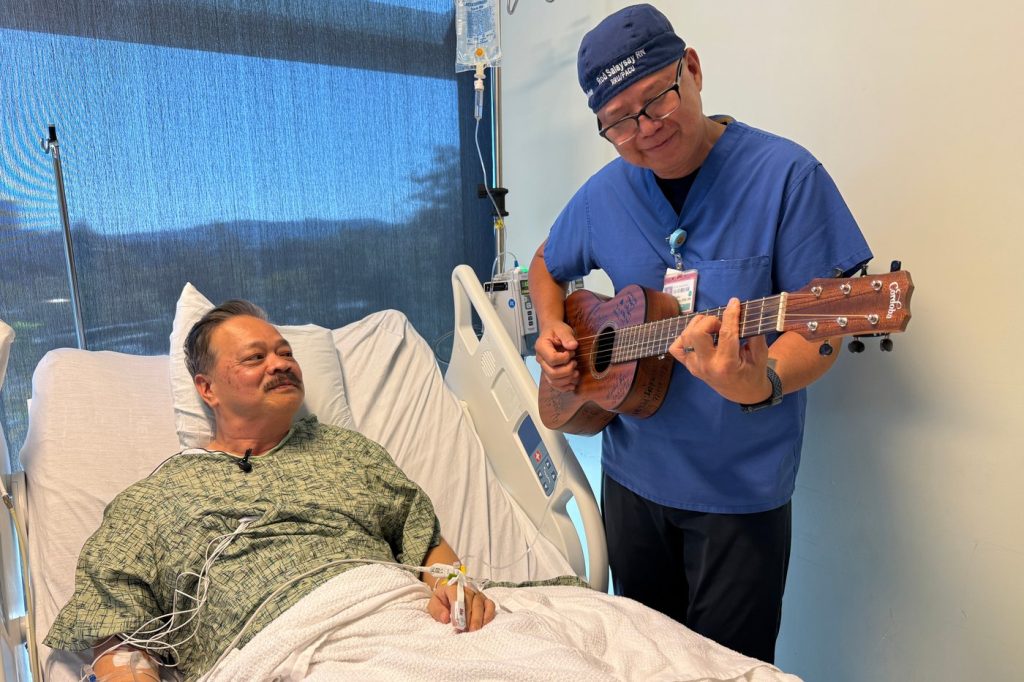Nurse Rod Salaysay, working in the recovery unit at UC San Diego Health, employs various instruments to aid patients, including traditional medical tools like thermometers and stethoscopes, as well as his guitar and ukulele. He assists patients in managing pain after surgery by not only administering medications but also offering music, which can have a profound impact on their recovery experience. His repertoire includes folk songs in English and Spanish, classical pieces like Minuet in G Major, and popular movie songs such as "Somewhere Over the Rainbow." Patients responding to his musical interventions often smile, show signs of relaxation, and may even request fewer painkillers.
Salaysay emphasizes that music can interrupt the cycle of worry, pain, and anxiety often prevalent in hospital settings. His approach aligns with broader trends observed in the healthcare industry over the past two decades, where live performances and recorded music have been integrated into various medical environments, supported by growing research into how music can alleviate pain.
The concept of music-induced analgesia—how music influences pain perception—is gaining traction, with numerous studies highlighting music's potential to reduce pain sensations or enhance pain tolerance. It’s important for patients or their families to select the music themselves and engage with it actively, rather than treating it as mere background noise.
According to psychologists, pain is a multifaceted experience, influenced by physical sensations, thoughts, and emotional responses. This complexity means that pain experiences can vary significantly between individuals. Acute pain arises from immediate physical stimuli, while chronic pain often involves long-term changes in how the brain processes pain signals, making patients more sensitive to pain.
Research indicates that music can redirect attention away from pain, essentially diminishing its perceived intensity. Studies have shown that personal preferences in music—listening to favored genres—are more effective in alleviating pain than passive listening, such as to podcasts. Music not only distracts but also engages neural pathways in the brain that can alter the experience of pain and associated feelings of isolation and anxiety.
The investigation into music's healing properties has a long history, dating back to late 19th-century practices in dental care. Currently, researchers are examining which conditions and settings optimize the effectiveness of music in pain management. A notable study conducted at Erasmus University Rotterdam involved 548 participants subjected to cold, inflicting acute pain while listening to different music genres: classical, rock, pop, urban, and electronic. Although all music was beneficial, no single genre proved superior. The findings underscored that listening to preferred music, regardless of genre, enhances pain endurance, likely due to increased emotional and memory engagement with familiar melodies.
Empowerment through music selection plays a crucial role in pain management. Allowing patients to choose their music fosters a sense of agency, giving them control over their treatment amid potentially chronic health conditions. Active engagement in music listening also appears to contribute significantly to pain relief, with studies suggesting that focused attention to music can yield considerable psychological benefits, illuminating different brain regions and promoting a positive emotional state.
In conclusion, the use of music as a therapeutic tool presents a simple yet effective strategy for pain management in healthcare settings. With no known adverse effects, this approach offers an alternative to traditional pain relief methods, drawing on the inherent healing qualities of music to help patients cope with their pain. As expressed by jazz singer Cecily Gardner, music not only reduces stress but also fosters community and provides an avenue to transcend difficult experiences.












